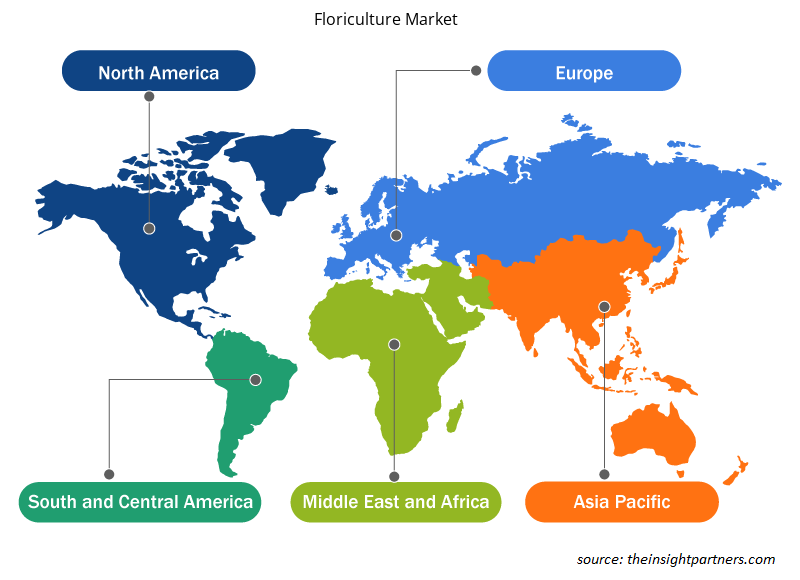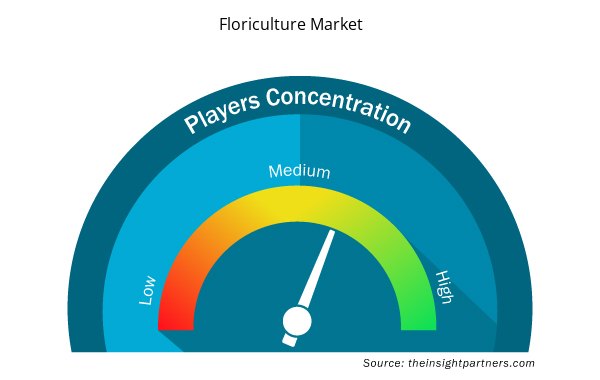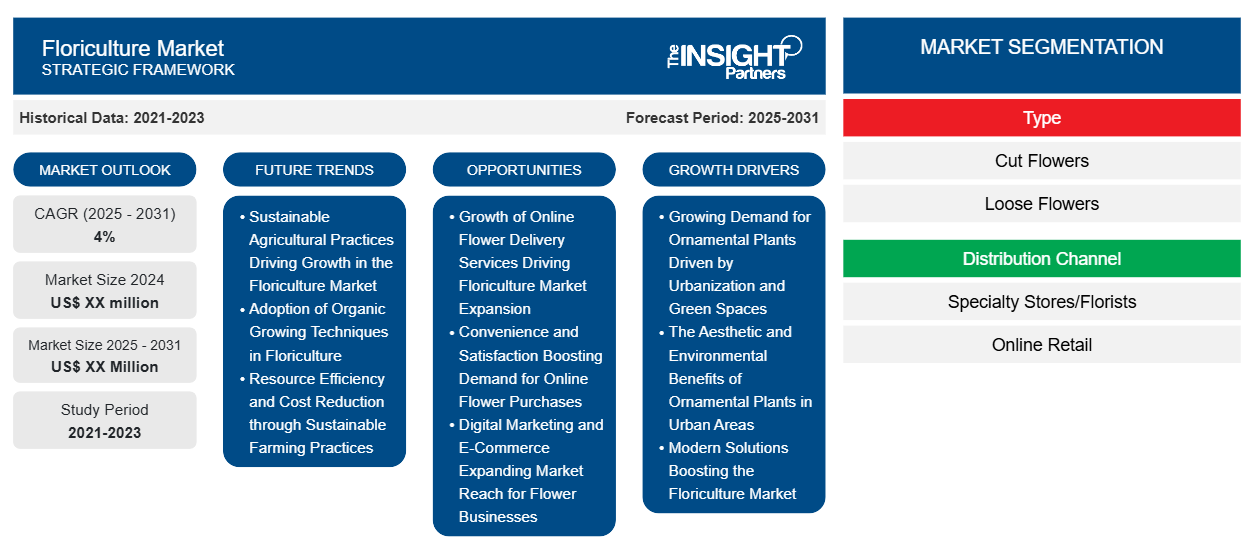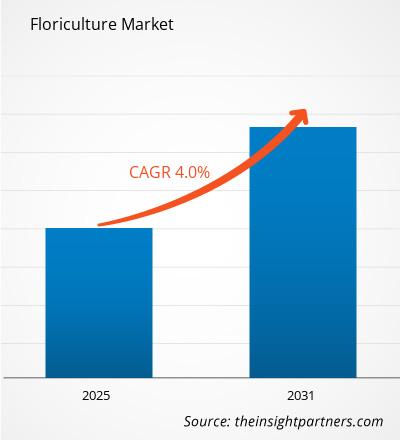من المتوقع أن يسجل سوق زراعة الزهور معدل نمو سنوي مركب بنسبة 4٪ من عام 2024 إلى عام 2031، مع توسع حجم السوق من XX مليون دولار أمريكي في عام 2024 إلى XX مليون دولار أمريكي بحلول عام 2031.
يقدم التقرير تحليلاً يعتمد على النوع (الزهور المقطوفة، والزهور السائبة، وغيرها). يتم تقسيم التقرير حسب قناة التوزيع (المتاجر المتخصصة/بائعي الزهور، وتجارة التجزئة عبر الإنترنت، وغيرها). يتم تقسيم التحليل العالمي بشكل أكبر على المستوى الإقليمي والدول الرئيسية. يتم تغطية حجم السوق والتوقعات على المستويات العالمية والإقليمية والقطرية لجميع قطاعات السوق الرئيسية ضمن النطاق. يقدم التقرير القيمة بالدولار الأمريكي للتحليل والقطاعات المذكورة أعلاه. يقدم التقرير إحصائيات رئيسية عن حالة السوق للاعبين الرئيسيين في السوق ويعرض اتجاهات السوق والفرص.
غرض التقرير
يهدف تقرير سوق زراعة الزهور الصادر عن The Insight Partners إلى وصف المشهد الحالي والنمو المستقبلي وأهم العوامل الدافعة والتحديات والفرص. وسيوفر هذا رؤى لمختلف أصحاب المصلحة في الأعمال التجارية، مثل:
- مزودي/مصنعي التكنولوجيا: لفهم ديناميكيات السوق المتطورة ومعرفة فرص النمو المحتملة، وتمكينهم من اتخاذ قرارات استراتيجية مستنيرة.
- المستثمرون: إجراء تحليل شامل للاتجاهات فيما يتعلق بمعدل نمو السوق، وتوقعات السوق المالية، والفرص المتاحة عبر سلسلة القيمة.
- الهيئات التنظيمية: لتنظيم السياسات ومراقبة الأنشطة في السوق بهدف تقليل الانتهاكات والحفاظ على ثقة المستثمرين ودعم سلامة السوق واستقرارها.
تجزئة سوق زراعة الزهور
يكتب
- الزهور المقطوفة
- الزهور السائبة
قناة التوزيع
- المتاجر المتخصصة/محلات الزهور
- البيع بالتجزئة عبر الإنترنت
قم بتخصيص هذا التقرير ليناسب متطلباتك
ستحصل على تخصيص لأي تقرير - مجانًا - بما في ذلك أجزاء من هذا التقرير، أو تحليل على مستوى الدولة، وحزمة بيانات Excel، بالإضافة إلى الاستفادة من العروض والخصومات الرائعة للشركات الناشئة والجامعات
- احصل على أهم اتجاهات السوق الرئيسية لهذا التقرير.ستتضمن هذه العينة المجانية تحليلاً للبيانات، بدءًا من اتجاهات السوق وحتى التقديرات والتوقعات.
محركات نمو سوق زراعة الزهور
- الطلب المتزايد على النباتات الزينة مدفوعًا بالتحضر والمساحات الخضراء: إن تفضيل المستهلكين المتزايد للنباتات الزينة لاستخدامها في المناظر الطبيعية هو مفتاح سوق زراعة الزهور المتزايدة. مع الاتجاه العالمي للتحضر وتوسع المدن والحاجة إلى المزيد من المساحات الخضراء، هناك حاجة أكبر إلى النباتات الزينة لأغراض جمالية لزيادة جاذبية المدن. وهذا جزء من الرغبة الأكبر التي يتم الشعور بها في مدن أفضل وأكثر خضرة.
- الفوائد الجمالية والبيئية للنباتات الزينة في المناطق الحضرية: بدأ الناس الذين يعيشون في بيئات المدن يقدرون جمال وأهمية النباتات الخضراء، بما في ذلك المساحات الخضراء التي تعمل على تحسين جودة الهواء وتعزيز الحالة المزاجية. يتم وضع النباتات الزينة مثل الأشجار المزهرة والشجيرات الجذابة لأغراض جمالية وتلعب دورًا في حماية البيئة. وبالتالي، يتم دمج هذه النباتات بشكل متزايد في تصميمات المدن من قبل الحكومات المحلية وكذلك مصممي المناظر الطبيعية.
- الحلول الحديثة تعزز سوق زراعة الزهور: فضلاً عن ذلك، ساهمت الحدائق العمودية ومناظر الأسطح أيضًا في زيادة الإقبال على النباتات الزينة. تتيح تقنيات البستنة الحديثة لسكان المدن ممارسة البستنة في المساحات الصغيرة المتاحة، بل وتعزز أيضًا الغطاء النباتي لمكافحة الحرارة في المدن. وبالتالي، فقد جذب هذا قدرًا كبيرًا من الاهتمام من قبل الكيانات التجارية والفردية على حد سواء، مما ساعد في زيادة سوق زراعة الزهور.
اتجاهات مستقبلية لسوق زراعة الزهور
- الممارسات الزراعية المستدامة تدفع النمو في سوق زراعة الزهور: إن تبني الأساليب الزراعية المستدامة والمركزة على البيئة هو أحد العوامل الرئيسية التي تساهم في زيادة سوق زراعة الزهور. ونظرًا للوعي الواسع النطاق بالقضايا البيئية، فإن الاتجاه هو أن تتم زراعة الزهور والنباتات بأقل تأثير بيئي ممكن. وهذا الطلب بدوره يجعل المزارعين يغيرون طريقة عملهم من خلال اعتماد استخدام أقل للمواد الكيميائية وتطبيقات بيولوجية أكثر وفقًا لتوقعات المستهلكين.
- اعتماد تقنيات الزراعة العضوية في زراعة الزهور: يتبنى مزارعو الزهور في البيوت الزجاجية ببطء تقنيات الزراعة العضوية مثل القضاء على الآفات والسيطرة عليها باستخدام السماد الطبيعي. مثل هذه الإجراءات صديقة للبيئة وتحسن الجودة العامة للنباتات المنتجة. كما يتجه السوق نحو الزهور العضوية حيث أصبح الناس الآن أكثر وعياً بصحتهم، وبالتالي فإن الطلب على الزهور المزروعة عضوياً آخذ في الازدياد.
- كفاءة الموارد وخفض التكاليف من خلال ممارسات الزراعة المستدامة: علاوة على ذلك، أصبحت أنظمة الري الموفرة للمياه واستخدام الطاقة المتجددة في الإنتاج أمرًا أساسيًا الآن. تعمل هذه الممارسات على تعزيز كفاءة الموارد وخفض تكاليف الإنتاج، وبالتالي جعل الممارسات المستدامة ممكنة للمزارعين. وبالتالي، فمن المتوقع أن تحقق الشركات التي تشارك في الزراعة الصديقة للبيئة أداءً أفضل في العمل.
فرص سوق زراعة الزهور
- نمو خدمات توصيل الزهور عبر الإنترنت يقود إلى توسيع سوق زراعة الزهور: من المتوقع أن ينمو تسويق الزهور والنباتات بسبب الشعبية المتزايدة لخدمات توصيل الزهور عبر الإنترنت. مع تطور التجارة الإلكترونية، يلجأ كل عمل وأي شخص يرغب في شراء أي منتج من اختياره إلى الإنترنت للبحث عن المنتجات الزهرية لأن هذا أكثر ملاءمة. وهذا استجابة للبيئة المزدحمة التي نشهدها وسلوك المستهلك المتغير.
- الراحة والرضا يعززان الطلب على شراء الزهور عبر الإنترنت: تتيح خدمات توصيل الزهور عبر الإنترنت للعملاء البحث واختيار أي عدد من التصميمات والأنماط المتاحة. وبالتالي، يكاد يكون من المستحيل الفشل في العثور على هدية مناسبة لأي مناسبة. إن طلب المنتجات من راحة المنزل وتوفير خدمات التوصيل في نفس اليوم للمستهلكين يحقق المزيد من الرضا، مما يعني المزيد من الشراء في المستقبل. تشجع هذه الزيادة في العرض شركات زراعة الزهور على تعزيز إمداداتها عبر الإنترنت.
- التسويق الرقمي والتجارة الإلكترونية يوسعان نطاق الوصول إلى السوق لشركات الزهور: بالإضافة إلى ذلك، وبمساعدة هذه المصادر عبر الإنترنت، تتمكن شركات الزهور من بيع منتجاتها للعملاء خارج منطقتها. يتيح التسويق الرقمي للشركة إنشاء مخزون واسع النطاق وتسويقه لأكبر عدد ممكن من الأفراد في جميع أنحاء البلاد. إنه يفتح أسواقًا جديدة وفرص مبيعات أكثر للمزارعين وتجار التجزئة.
رؤى إقليمية حول سوق زراعة الزهور
لقد قام المحللون في Insight Partners بشرح الاتجاهات والعوامل الإقليمية المؤثرة على سوق زراعة الزهور طوال فترة التوقعات بشكل شامل. يناقش هذا القسم أيضًا قطاعات سوق زراعة الزهور والجغرافيا في جميع أنحاء أمريكا الشمالية وأوروبا ومنطقة آسيا والمحيط الهادئ والشرق الأوسط وأفريقيا وأمريكا الجنوبية والوسطى.

- احصل على البيانات الإقليمية المحددة لسوق زراعة الزهور
نطاق تقرير سوق زراعة الزهور
| سمة التقرير | تفاصيل |
|---|---|
| حجم السوق في عام 2024 | XX مليون دولار أمريكي |
| حجم السوق بحلول عام 2031 | XX مليون دولار أمريكي |
| معدل النمو السنوي المركب العالمي (2025 - 2031) | 4% |
| البيانات التاريخية | 2021-2023 |
| فترة التنبؤ | 2025-2031 |
| القطاعات المغطاة | حسب النوع
|
| المناطق والدول المغطاة | أمريكا الشمالية
|
| قادة السوق وملفات تعريف الشركات الرئيسية |
|
كثافة اللاعبين في سوق زراعة الزهور: فهم تأثيرها على ديناميكيات الأعمال
يشهد سوق زراعة الزهور نموًا سريعًا، مدفوعًا بالطلب المتزايد من جانب المستخدم النهائي بسبب عوامل مثل تفضيلات المستهلكين المتطورة والتقدم التكنولوجي والوعي المتزايد بفوائد المنتج. ومع ارتفاع الطلب، تعمل الشركات على توسيع عروضها والابتكار لتلبية احتياجات المستهلكين والاستفادة من الاتجاهات الناشئة، مما يؤدي إلى زيادة نمو السوق.
تشير كثافة اللاعبين في السوق إلى توزيع الشركات أو المؤسسات العاملة في سوق أو صناعة معينة. وهي تشير إلى عدد المنافسين (اللاعبين في السوق) الموجودين في مساحة سوق معينة نسبة إلى حجمها أو قيمتها السوقية الإجمالية.
الشركات الرئيسية العاملة في سوق زراعة الزهور هي:
- دانزيجر
- برتقال دومين
- كارين روزيس
- شركة كاروتوري العالمية المحدودة
- متعدد الأزهار
إخلاء المسؤولية : الشركات المذكورة أعلاه ليست مرتبة بأي ترتيب معين.

- احصل على نظرة عامة على أهم اللاعبين الرئيسيين في سوق زراعة الزهور
نقاط البيع الرئيسية
- التغطية الشاملة: يغطي التقرير بشكل شامل تحليل المنتجات والخدمات والأنواع والمستخدمين النهائيين لسوق زراعة الزهور، مما يوفر صورة شاملة.
- تحليل الخبراء: تم تجميع التقرير على أساس الفهم العميق لخبراء الصناعة والمحللين.
- معلومات محدثة: يضمن التقرير أهمية الأعمال التجارية بسبب تغطيته للمعلومات الحديثة واتجاهات البيانات.
- خيارات التخصيص: يمكن تخصيص هذا التقرير لتلبية متطلبات العملاء المحددة وبما يتناسب مع استراتيجيات العمل بشكل مناسب.
وبالتالي، يمكن أن يساعد تقرير البحث حول سوق زراعة الزهور في تمهيد الطريق لفك شفرة وفهم سيناريو الصناعة وآفاق النمو. ورغم وجود بعض المخاوف المشروعة، فإن الفوائد الإجمالية لهذا التقرير تميل إلى التفوق على العيوب.
- التحليل التاريخي (سنتان)، السنة الأساسية، التوقعات (7 سنوات) مع معدل النمو السنوي المركب
- تحليل PEST و SWOT
- حجم السوق والقيمة / الحجم - عالميًا وإقليميًا وقطريًا
- الصناعة والمنافسة
- مجموعة بيانات Excel


- Electronic Data Interchange Market
- Foot Orthotic Insoles Market
- Underwater Connector Market
- Sterilization Services Market
- Terahertz Technology Market
- Cosmetic Bioactive Ingredients Market
- Rare Neurological Disease Treatment Market
- Broth Market
- Redistribution Layer Material Market
- Pipe Relining Market

Report Coverage
Revenue forecast, Company Analysis, Industry landscape, Growth factors, and Trends

Segment Covered
This text is related
to segments covered.

Regional Scope
North America, Europe, Asia Pacific, Middle East & Africa, South & Central America

Country Scope
This text is related
to country scope.
الأسئلة الشائعة
Sustainable and eco-friendly cultivation practices is expected to be the key market trends.
Based on type, the cut flowers segment is expected to witness the fastest growth during the forecast period
Based on geography, North America held the largest share of the floriculture market due to the region's strong demand for floral products driven by cultural celebrations, events, and a growing trend towards home gardening and landscaping.
The increasing demand for ornamental plants in urban landscaping is driving the market growth.
DANZIGER; Dummen Orange; Marginpar BV; Syngenta; KAREN ROSES; Multiflora; Selecta Cut Flowers; The Queen’s Flowers; Flamingo; and ESMERALDA FARMS are some of the key players operating in the floriculture market
The Floriculture Market is estimated to witness a CAGR of 4% from 2023 to 2031
Trends and growth analysis reports related to Chemicals and Materials : READ MORE..
1. Danziger
2. Dummen Orange
3. Karen Roses
4. Karuturi Global Limited
5. Multiflora
6. Oserian
7. Ruparelia Group
8. Selecta Klemm
9. Syngenta Flowers Inc.
10. The Kariki Group
The Insight Partners performs research in 4 major stages: Data Collection & Secondary Research, Primary Research, Data Analysis and Data Triangulation & Final Review.
- Data Collection and Secondary Research:
As a market research and consulting firm operating from a decade, we have published and advised several client across the globe. First step for any study will start with an assessment of currently available data and insights from existing reports. Further, historical and current market information is collected from Investor Presentations, Annual Reports, SEC Filings, etc., and other information related to company’s performance and market positioning are gathered from Paid Databases (Factiva, Hoovers, and Reuters) and various other publications available in public domain.
Several associations trade associates, technical forums, institutes, societies and organization are accessed to gain technical as well as market related insights through their publications such as research papers, blogs and press releases related to the studies are referred to get cues about the market. Further, white papers, journals, magazines, and other news articles published in last 3 years are scrutinized and analyzed to understand the current market trends.
- Primary Research:
The primarily interview analysis comprise of data obtained from industry participants interview and answers to survey questions gathered by in-house primary team.
For primary research, interviews are conducted with industry experts/CEOs/Marketing Managers/VPs/Subject Matter Experts from both demand and supply side to get a 360-degree view of the market. The primary team conducts several interviews based on the complexity of the markets to understand the various market trends and dynamics which makes research more credible and precise.
A typical research interview fulfils the following functions:
- Provides first-hand information on the market size, market trends, growth trends, competitive landscape, and outlook
- Validates and strengthens in-house secondary research findings
- Develops the analysis team’s expertise and market understanding
Primary research involves email interactions and telephone interviews for each market, category, segment, and sub-segment across geographies. The participants who typically take part in such a process include, but are not limited to:
- Industry participants: VPs, business development managers, market intelligence managers and national sales managers
- Outside experts: Valuation experts, research analysts and key opinion leaders specializing in the electronics and semiconductor industry.
Below is the breakup of our primary respondents by company, designation, and region:

Once we receive the confirmation from primary research sources or primary respondents, we finalize the base year market estimation and forecast the data as per the macroeconomic and microeconomic factors assessed during data collection.
- Data Analysis:
Once data is validated through both secondary as well as primary respondents, we finalize the market estimations by hypothesis formulation and factor analysis at regional and country level.
- Macro-Economic Factor Analysis:
We analyse macroeconomic indicators such the gross domestic product (GDP), increase in the demand for goods and services across industries, technological advancement, regional economic growth, governmental policies, the influence of COVID-19, PEST analysis, and other aspects. This analysis aids in setting benchmarks for various nations/regions and approximating market splits. Additionally, the general trend of the aforementioned components aid in determining the market's development possibilities.
- Country Level Data:
Various factors that are especially aligned to the country are taken into account to determine the market size for a certain area and country, including the presence of vendors, such as headquarters and offices, the country's GDP, demand patterns, and industry growth. To comprehend the market dynamics for the nation, a number of growth variables, inhibitors, application areas, and current market trends are researched. The aforementioned elements aid in determining the country's overall market's growth potential.
- Company Profile:
The “Table of Contents” is formulated by listing and analyzing more than 25 - 30 companies operating in the market ecosystem across geographies. However, we profile only 10 companies as a standard practice in our syndicate reports. These 10 companies comprise leading, emerging, and regional players. Nonetheless, our analysis is not restricted to the 10 listed companies, we also analyze other companies present in the market to develop a holistic view and understand the prevailing trends. The “Company Profiles” section in the report covers key facts, business description, products & services, financial information, SWOT analysis, and key developments. The financial information presented is extracted from the annual reports and official documents of the publicly listed companies. Upon collecting the information for the sections of respective companies, we verify them via various primary sources and then compile the data in respective company profiles. The company level information helps us in deriving the base number as well as in forecasting the market size.
- Developing Base Number:
Aggregation of sales statistics (2020-2022) and macro-economic factor, and other secondary and primary research insights are utilized to arrive at base number and related market shares for 2022. The data gaps are identified in this step and relevant market data is analyzed, collected from paid primary interviews or databases. On finalizing the base year market size, forecasts are developed on the basis of macro-economic, industry and market growth factors and company level analysis.
- Data Triangulation and Final Review:
The market findings and base year market size calculations are validated from supply as well as demand side. Demand side validations are based on macro-economic factor analysis and benchmarks for respective regions and countries. In case of supply side validations, revenues of major companies are estimated (in case not available) based on industry benchmark, approximate number of employees, product portfolio, and primary interviews revenues are gathered. Further revenue from target product/service segment is assessed to avoid overshooting of market statistics. In case of heavy deviations between supply and demand side values, all thes steps are repeated to achieve synchronization.
We follow an iterative model, wherein we share our research findings with Subject Matter Experts (SME’s) and Key Opinion Leaders (KOLs) until consensus view of the market is not formulated – this model negates any drastic deviation in the opinions of experts. Only validated and universally acceptable research findings are quoted in our reports.
We have important check points that we use to validate our research findings – which we call – data triangulation, where we validate the information, we generate from secondary sources with primary interviews and then we re-validate with our internal data bases and Subject matter experts. This comprehensive model enables us to deliver high quality, reliable data in shortest possible time.


 احصل على عينة مجانية لهذا التقرير
احصل على عينة مجانية لهذا التقرير